engine SUBARU LEGACY 2005 4.G Owner's Manual
[x] Cancel search | Manufacturer: SUBARU, Model Year: 2005, Model line: LEGACY, Model: SUBARU LEGACY 2005 4.GPages: 627, PDF Size: 6.42 MB
Page 188 of 627
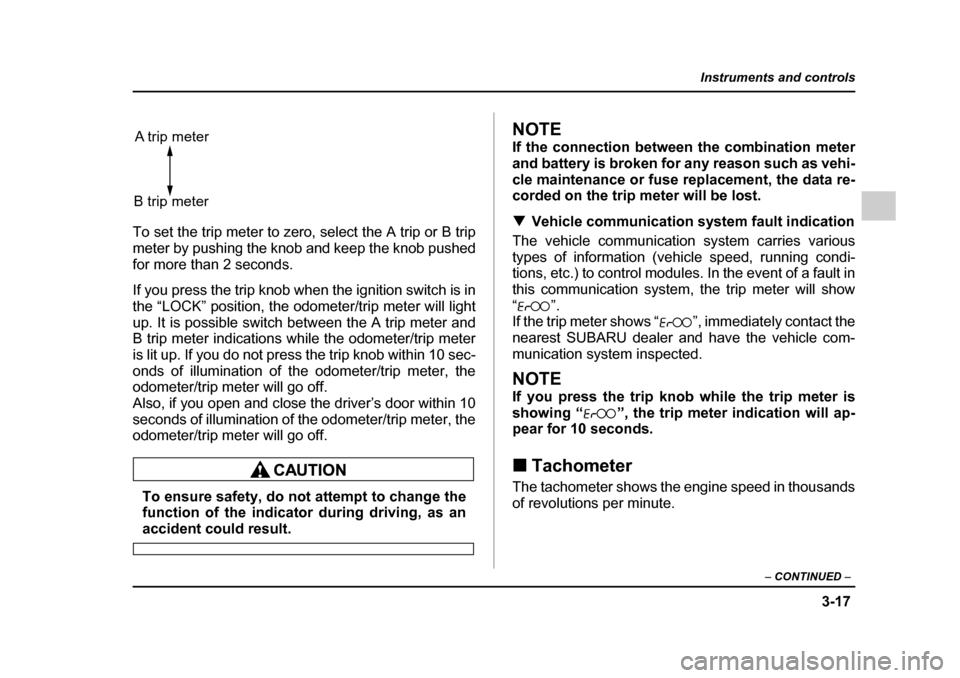
3-17
Instruments and controls
– CONTINUED –
To set the trip meter to zero, select the A trip or B trip
meter by pushing the knob and keep the knob pushed for more than 2 seconds.
If you press the trip knob when the ignition switch is in
the “LOCK” position, the odometer/trip meter will light
up. It is possible switch between the A trip meter and
B trip meter indications while the odometer/trip meter
is lit up. If you do not press the trip knob within 10 sec-
onds of illumination of the odometer/trip meter, the
odometer/trip meter will go off.
Also, if you open and close the driver’s door within 10
seconds of illumination of the odometer/trip meter, the
odometer/trip meter will go off.
To ensure safety, do not attempt to change the
function of the indicator during driving, as an
accident could result.
NOTE
If the connection between the combination meter
and battery is broken for any reason such as vehi-
cle maintenance or fuse replacement, the data re-
corded on the trip meter will be lost. !Vehicle communication system fault indication
The vehicle communication system carries various
types of information (vehicle speed, running condi-
tions, etc.) to control modules. In the event of a fault in
this communication system, the trip meter will show“” .
If the trip meter shows “ ”, immediately contact the
nearest SUBARU dealer and have the vehicle com-
munication system inspected.
NOTE
If you press the trip knob while the trip meter is
showing “ ”, the trip meter indication will ap-
pear for 10 seconds. ! Tachometer
The tachometer shows the engine speed in thousands
of revolutions per minute.
A trip meter
B trip meter
Page 189 of 627

3-18
Instruments and controls
Do not operate the engine with the pointer of
the tachometer in the red zone. In this range,
fuel injection will be cut by the engine control
module to protect the engine from overrevving.
The engine will resume running normally after
the engine speed is reduced below the red
zone.
NOTE (3.0-liter models only)
To protect the engine while the “P” or “N” position
is selected, the engine is controlled such that the
engine speed does not become too high even if
the accelerator pedal is pressed hard.
!
Fuel gauge
The fuel gauge shows the approximate amount of fuel
remaining in the tank.
The gauge does not return to “E” even though the ig-
nition switch is in the “ACC” or “LOCK” position.
The gauge may move slightly during braking, turning
or acceleration due to fuel level movement in the tank.
If you press the trip knob while the ignition switch is in
the “LOCK” position, the fuel gauge’s dial will light up
and the needle will indicate the amount of fuel remain-
ing in the tank.
If, while the fuel gauge needle is indicating the amount
of fuel remaining in the tank, you (a) do not press the
UB3212AA
Page 190 of 627

3-19
Instruments and controls
– CONTINUED –
trip knob for 10 seconds or (b) open and close the driv-
er’s door, the fuel gauge needle will drop to the “E” po-
sition and the dial, needle, and rim will go off.
NOTE
You will see the “ ” sign in the combination
meter.
This indicates that the fuel filler door (lid) is locat-
ed on the right side of the vehicle. !Low fuel warning light
The low fuel warning light comes on when the tank is
nearly empty [About 2.6 US gal (10 liters, 2.2 lmp gal)].
It only operates when the ignition switch is in the “ON” position.
NOTE
This light does not go out unless the tank is re-
plenished up to an internal fuel quantity of about
4.0 US gal (15 liters, 3,3 lmp gal). !
Temperature gauge
A) Normal operating range
The temperature gauge shows engine coolant temper-
ature when the ignition switch is in the “ON” position.
The coolant temperature will vary in accordance with
the outside temperature and driving conditions.
UB3526AA
A
UB3548BB
Page 191 of 627
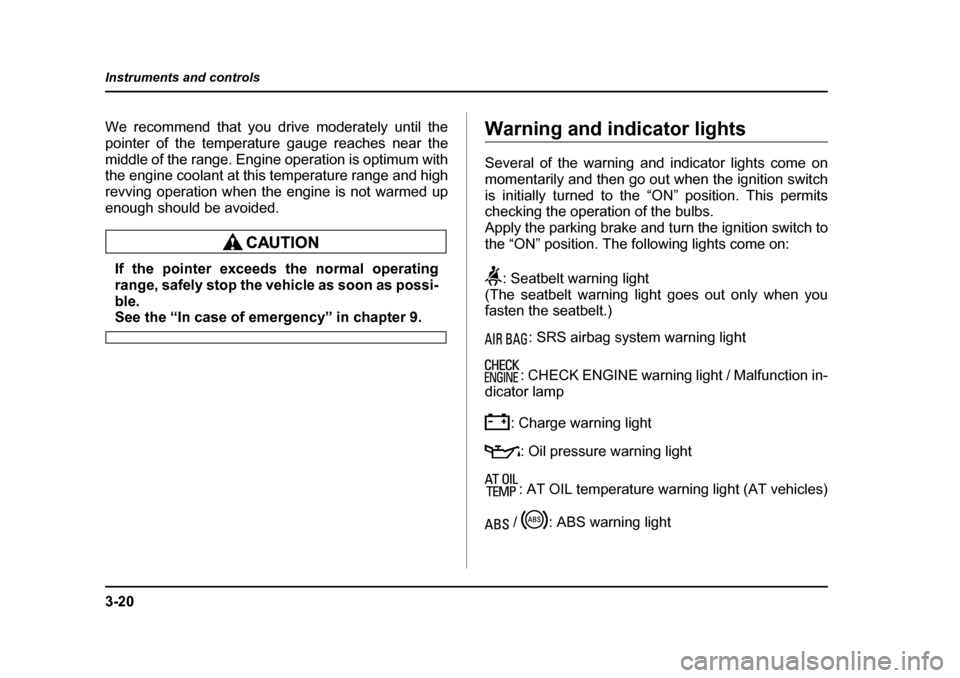
3-20
Instruments and controls
We recommend that you drive moderately until the
pointer of the temperature gauge reaches near the
middle of the range. Engine operation is optimum with
the engine coolant at this temperature range and high
revving operation when the engine is not warmed up
enough should be avoided.
If the pointer exceeds the normal operating
range, safely stop the vehicle as soon as possi-
ble.
See the “In case of emergency” in chapter 9.
Warning and indicator lights
Several of the warning and indicator lights come on
momentarily and then go out when the ignition switch
is initially turned to the “ON” position. This permits
checking the operation of the bulbs.
Apply the parking brake and turn the ignition switch to
the “ON” position. The following lights come on:
: Seatbelt warning light
(The seatbelt warning light goes out only when you
fasten the seatbelt.)
: SRS airbag system warning light
: CHECK ENGINE warning light / Malfunction in-
dicator lamp
: Charge warning light: Oil pressure warning light
: AT OIL temperature warning light (AT vehicles)
/ : ABS warning light
Page 196 of 627
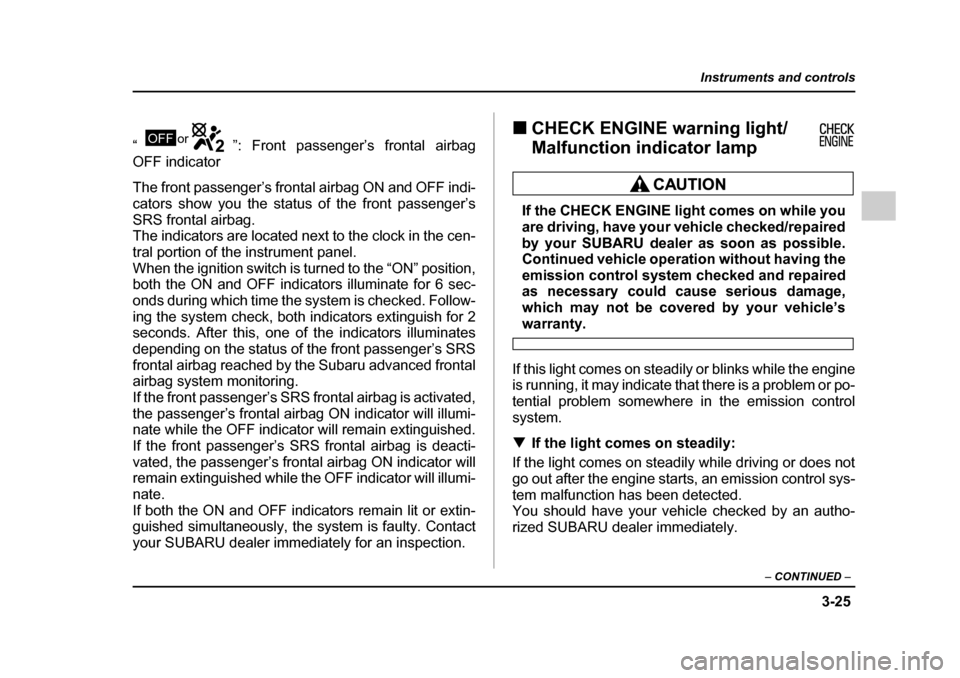
3-25
Instruments and controls
– CONTINUED –
“ ”: Front passenger’s frontal airbag
OFF indicator
The front passenger’s frontal airbag ON and OFF indi-
cators show you the status of the front passenger’s
SRS frontal airbag.
The indicators are located next to the clock in the cen-
tral portion of the instrument panel.
When the ignition switch is turned to the “ON” position,
both the ON and OFF indicators illuminate for 6 sec- onds during which time the system is checked. Follow-
ing the system check, both indicators extinguish for 2
seconds. After this, one of the indicators illuminates
depending on the status of the front passenger’s SRS
frontal airbag reached by the Subaru advanced frontal airbag system monitoring.
If the front passenger’s SRS frontal airbag is activated,
the passenger’s frontal airbag ON indicator will illumi-
nate while the OFF indicator will remain extinguished.
If the front passenger’s SRS frontal airbag is deacti-
vated, the passenger’s frontal airbag ON indicator will
remain extinguished while the OFF indicator will illumi-
nate.
If both the ON and OFF indicators remain lit or extin-
guished simultaneously, the system is faulty. Contact
your SUBARU dealer immediately for an inspection. !
CHECK ENGINE warning light/
Malfunction indicator lamp
If the CHECK ENGINE light comes on while you
are driving, have your vehicle checked/repaired
by your SUBARU dealer as soon as possible.
Continued vehicle operation without having the
emission control system checked and repaired
as necessary could cause serious damage,
which may not be covered by your vehicle’s
warranty.
If this light comes on steadily or blinks while the engine
is running, it may indicate that there is a problem or po-
tential problem somewhere in the emission control system. ! If the light comes on steadily:
If the light comes on steadily while driving or does not
go out after the engine starts, an emission control sys-
tem malfunction has been detected.
You should have your vehicle checked by an autho-
rized SUBARU dealer immediately.
OFF or
Page 197 of 627

3-26
Instruments and controls
NOTE
This light also comes on when the fuel filler cap is
not tightened until it clicks.
If you have recently refueled your vehicle, the cause of
the CHECK ENGINE warning light/malfunction indica-
tor lamp coming on could be a loose or missing fuel fill-
er cap. Remove the cap and retighten it until it clicks.
Make sure nothing is interfering with the sealing of the
cap. Tightening the cap will not make the CHECK EN-
GINE warning light turn off immediately. It may take
several driving trips. If the light does not go out, take
your vehicle to your authorized SUBARU dealer im-
mediately. !
If the light is blinking:
If the light is blinking while driving, an engine misfire
condition has been detected which may damage the
emission control system.
To prevent serious damage to the emission control
system, you should do the following:" Reduce vehicle speed.
" Avoid hard acceleration.
" Avoid steep uphill grades.
" Reduce the amount of cargo, if possible.
" Stop towing a trailer as soon as possible.
The CHECK ENGINE warning light may stop blinking and come on steadily after several driving trips. You
should have your vehicle checked by an authorized
SUBARU dealer immediately. !
Charge warning light
If this light comes on when the engine is running, it
may indicate that the charging system is not working
properly.
If the light comes on while driving or does not go out
after the engine starts, stop the engine at the first safe
opportunity and check the alternator belt. If the belt is
loose, broken or if the belt is in good condition but the
light remains on, contact your nearest SUBARU deal-
er immediately. ! Oil pressure warning light
Do not operate the engine with the oil pressure
warning light on. This may cause serious en-
gine damage.
If this light comes on when the engine is running, it
may indicate that the engine oil pressure is low and the
Page 198 of 627

3-27
Instruments and controls
– CONTINUED –
lubricating system is not working properly.
If the light comes on while driving or does not go out
after the engine starts, stop the engine at the first safe
opportunity and check the engine oil level. If the oil lev-
el is low, add oil immediately. If the engine oil is at the
proper level but the light remains on, contact your
nearest SUBARU dealer immediately. !AT OIL TEMPerature warning
light (AT vehicles)
The AT oil temperature warning light comes on when
the ignition switch is turned to the “ON” position and
goes out after about two seconds.
If this light comes on when the engine is running, it
may indicate that the automatic transmission fluid tem-
perature is too hot.
If the light comes on while driving, it is unnecessary to
stop the vehicle, but avoid driving up steep grades or
in stop and go traffic. ! Automatic transmission control system warn- ing
If the light flashes after the engine starts, it may indi-cate that the automatic transmission control system is
not working properly. Contact your nearest SUBARU
dealer for service immediately. !
Low tire pressure warning light (if
equipped)
When the ignition switch is turned to the “ON” position,
the low tire pressure warning light will come on for
about 2 seconds to check that the tire pressure moni-
toring system (TPMS) is functioning properly. If there
is no problem and all tires are properly inflated, the
light will go out.
When the tire pressure monitoring system warning
light is lit, one or more of your tires is significantly un-
der-inflated. You should stop and check your tires as
soon as possible, and inflate them to the proper pres-
sure as indicated on the vehicle’s tire information plac- ard.
Driving on a significantly under-inflated tire causes the
tire to overheat and can lead to tire failure. Under-in-
flation also reduces fuel efficiency and tire tread life,
and may affect the vehicle’s handling and stopping
ability. Each tire, including the spare, should be
checked monthly when cold and set to the recom-
mended inflation pressure as specified in the vehicle
placard and owner’s manual.
If this light does not come on briefly after the ig-
nition switch is turned ON or the light is flash-
Page 200 of 627
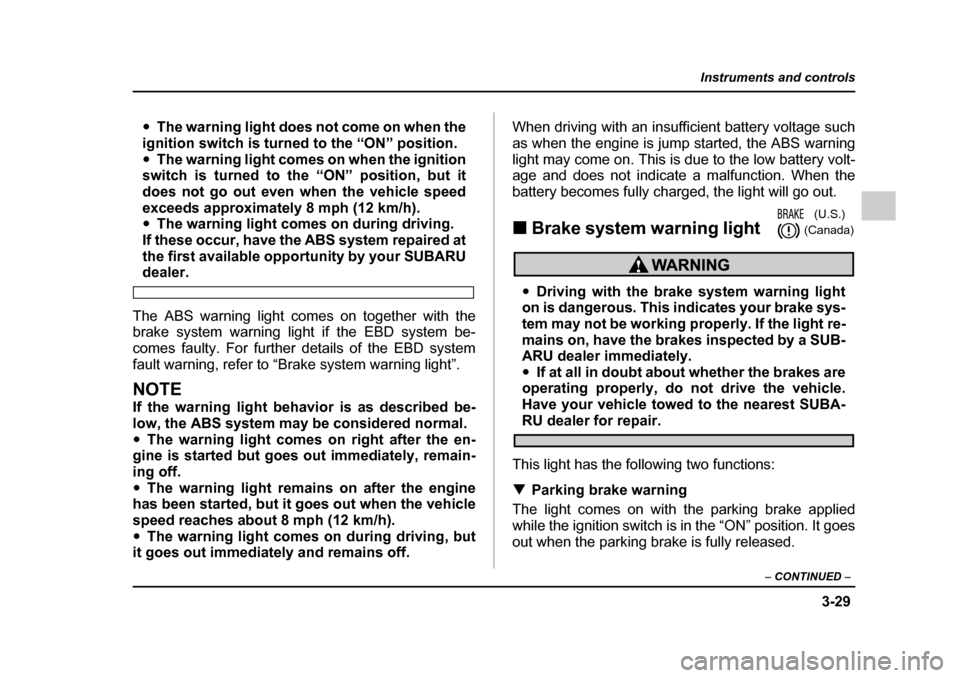
3-29
Instruments and controls
– CONTINUED –
"The warning light does not come on when the
ignition switch is turned to the “ON” position. " The warning light comes on when the ignition
switch is turned to the “ON” position, but it
does not go out even when the vehicle speed
exceeds approximately 8 mph (12 km/h). " The warning light comes on during driving.
If these occur, have the ABS system repaired at
the first available opportunity by your SUBARU
dealer.
The ABS warning light comes on together with the
brake system warning light if the EBD system be-
comes faulty. For further details of the EBD system
fault warning, refer to “Brake system warning light”.
NOTE
If the warning light behavior is as described be-
low, the ABS system may be considered normal." The warning light comes on right after the en-
gine is started but goes out immediately, remain-
ing off." The warning light remains on after the engine
has been started, but it goes out when the vehicle
speed reaches about 8 mph (12 km/h)." The warning light comes on during driving, but
it goes out immediately and remains off. When driving with an insufficient battery voltage suchas when the engine is jump started, the ABS warning
light may come on. This is due to the low battery volt-
age and does not indicate a malfunction. When the
battery becomes fully charged, the light will go out. !
Brake system warning light
"Driving with the brake system warning light
on is dangerous. This indicates your brake sys-
tem may not be working properly. If the light re-
mains on, have the brakes inspected by a SUB-
ARU dealer immediately." If at all in doubt about whether the brakes are
operating properly, do not drive the vehicle.
Have your vehicle towed to the nearest SUBA-
RU dealer for repair.
This light has the following two functions: ! Parking brake warning
The light comes on with the parking brake applied
while the ignition switch is in the “ON” position. It goes
out when the parking brake is fully released.
(U.S.) (Canada)
Page 201 of 627

3-30
Instruments and controls
!
Brake fluid level warning
This light comes on when the brake fluid level has
dropped to near the “MIN” level of the brake fluid res-
ervoir with the ignition switch in the “ON” position and
with the parking brake fully released. If the brake system warning light should come on while
driving (with the parking brake fully released and with
the ignition switch positioned in “ON”), it could be an
indication of leaking of brake fluid or worn brake pads.
If this occurs, immediately stop the vehicle at the near-
est safe place and check the brake fluid level. If the flu-
id level is below the “MIN” mark in the reservoir, do not
drive the vehicle. Have the vehicle towed to the near-
est SUBARU dealer for repair. ! Electronic Brake Force Distribution (EBD) sys-
tem warning
The brake system warning light also illuminates if a
malfunction occurs in the EBD system. In that event, it
comes on together with the ABS warning light.
The EBD system may be faulty if the brake system
warning light and ABS warning light illuminate simulta-
neously during driving.
Even if the EBD system fails, the conventional braking
system will still function. However, the rear wheels will
be more prone to locking when the brakes are applied
harder than usual and the vehicle’s motion may there- fore become somewhat harder to control.
If the brake system warning light and ABS warning
light illuminate simultaneously, take the following steps:
1. Stop the vehicle in the nearest safe, flat place.
2. Shut down the engine, then restart it.
3. Release the parking brake. If both warning lights go
out, the EBD system may be faulty.
Drive carefully to the nearest SUBARU dealer and
have the system inspected.
4. If both warning lights come on again and stay illu-
minated after the engine has been restarted, shut
down the engine again, apply the parking brake, and
check the brake fluid level.
5. If the brake fluid level is not below the “MIN” mark,
the EBD system may be faulty. Drive carefully to the
nearest SUBARU dealer and have the system inspect-
ed.
6. If the brake fluid level is below the “MIN” mark, DO
NOT drive the vehicle. Instead, have the vehicle towed
to the nearest SUBARU dealer for repair. !
Low fuel warning light
The low fuel warning light comes on when the tank is
nearly empty about 2.6 US gal (10.0 liters, or 2.2 Imp
gal). It only operates when the ignition switch is in the“ON” position.
Page 202 of 627
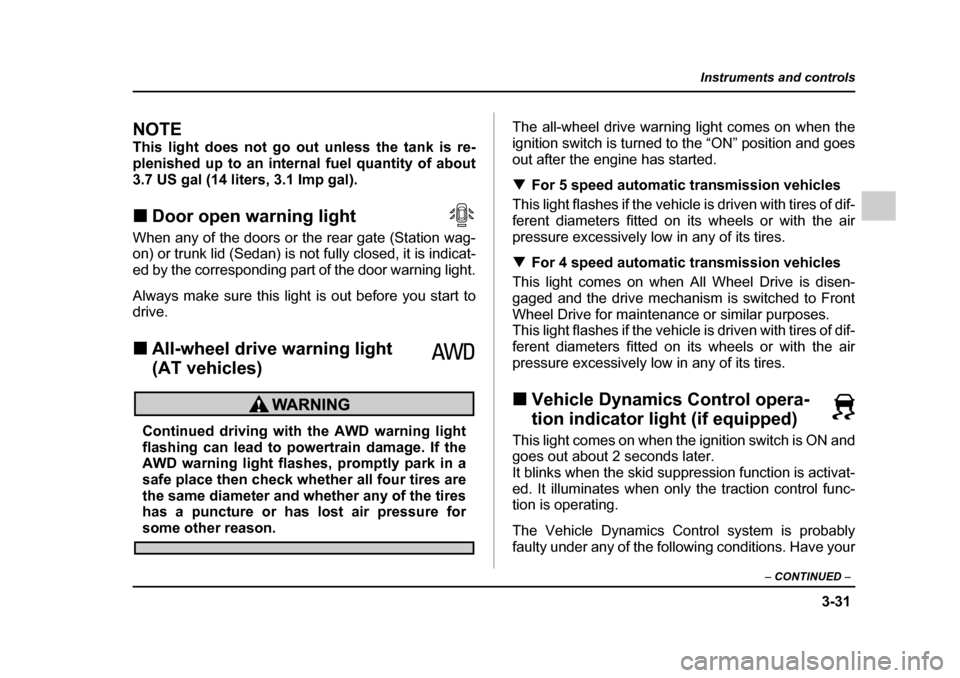
3-31
Instruments and controls
– CONTINUED –
NOTE
This light does not go out unless the tank is re-
plenished up to an internal fuel quantity of about
3.7 US gal (14 liters, 3.1 Imp gal). !Door open warning light
When any of the doors or the rear gate (Station wag-
on) or trunk lid (Sedan) is not fully closed, it is indicat-
ed by the corresponding part of the door warning light.
Always make sure this light is out before you start to
drive. ! All-wheel drive warning light
(AT vehicles)
Continued driving with the AWD warning light
flashing can lead to powertrain damage. If the
AWD warning light flashes, promptly park in a
safe place then check whether all four tires are
the same diameter and whether any of the tires
has a puncture or has lost air pressure for
some other reason. The all-wheel drive warning light comes on when the
ignition switch is turned to the “ON” position and goes
out after the engine has started. !
For 5 speed automatic transmission vehicles
This light flashes if the vehicle is driven with tires of dif-
ferent diameters fitted on its wheels or with the air
pressure excessively low in any of its tires. ! For 4 speed automatic transmission vehicles
This light comes on when All Wheel Drive is disen-
gaged and the drive mechanism is switched to Front
Wheel Drive for maintenance or similar purposes.
This light flashes if the vehicle is driven with tires of dif-
ferent diameters fitted on its wheels or with the air
pressure excessively low in any of its tires. ! Vehicle Dynamics Control opera-
tion indicator light (if equipped)
This light comes on when the ignition switch is ON and
goes out about 2 seconds later.
It blinks when the skid suppression function is activat-
ed. It illuminates when only the traction control func-
tion is operating.
The Vehicle Dynamics Control system is probably
faulty under any of the following conditions. Have your